+ Open data
Open data
- Basic information
Basic information
| Entry | Database: PDB / ID: 2l6j | ||||||
|---|---|---|---|---|---|---|---|
| Title | Tah1 complexed by MEEVD | ||||||
 Components Components |
| ||||||
 Keywords Keywords |  PROTEIN BINDING / tetratricopeptide repeat (TPR) / Hsp90 co-factor PROTEIN BINDING / tetratricopeptide repeat (TPR) / Hsp90 co-factor | ||||||
| Function / homology |  Function and homology information Function and homology information: / HSP90-CDC37 chaperone complex / positive regulation of cyclin-dependent protein kinase activity / R2TP complex / Aryl hydrocarbon receptor signalling / negative regulation of proteasomal protein catabolic process / dynein axonemal particle /  aryl hydrocarbon receptor complex / aryl hydrocarbon receptor complex /  histone methyltransferase binding / protein kinase regulator activity ...: / HSP90-CDC37 chaperone complex / positive regulation of cyclin-dependent protein kinase activity / R2TP complex / Aryl hydrocarbon receptor signalling / negative regulation of proteasomal protein catabolic process / dynein axonemal particle / histone methyltransferase binding / protein kinase regulator activity ...: / HSP90-CDC37 chaperone complex / positive regulation of cyclin-dependent protein kinase activity / R2TP complex / Aryl hydrocarbon receptor signalling / negative regulation of proteasomal protein catabolic process / dynein axonemal particle /  aryl hydrocarbon receptor complex / aryl hydrocarbon receptor complex /  histone methyltransferase binding / protein kinase regulator activity / positive regulation of protein localization to cell surface / ATP-dependent protein binding / box C/D snoRNP assembly / negative regulation of protein metabolic process / positive regulation of tau-protein kinase activity / histone methyltransferase binding / protein kinase regulator activity / positive regulation of protein localization to cell surface / ATP-dependent protein binding / box C/D snoRNP assembly / negative regulation of protein metabolic process / positive regulation of tau-protein kinase activity /  telomerase holoenzyme complex assembly / Uptake and function of diphtheria toxin / TPR domain binding / positive regulation of transforming growth factor beta receptor signaling pathway / dendritic growth cone / positive regulation of phosphoprotein phosphatase activity / Sema3A PAK dependent Axon repulsion / The NLRP3 inflammasome / regulation of protein ubiquitination / HSF1-dependent transactivation / telomere maintenance via telomerase / negative regulation of proteasomal ubiquitin-dependent protein catabolic process / response to unfolded protein / HSF1 activation / chaperone-mediated protein complex assembly / Attenuation phase / RHOBTB2 GTPase cycle / telomerase holoenzyme complex assembly / Uptake and function of diphtheria toxin / TPR domain binding / positive regulation of transforming growth factor beta receptor signaling pathway / dendritic growth cone / positive regulation of phosphoprotein phosphatase activity / Sema3A PAK dependent Axon repulsion / The NLRP3 inflammasome / regulation of protein ubiquitination / HSF1-dependent transactivation / telomere maintenance via telomerase / negative regulation of proteasomal ubiquitin-dependent protein catabolic process / response to unfolded protein / HSF1 activation / chaperone-mediated protein complex assembly / Attenuation phase / RHOBTB2 GTPase cycle /  DNA polymerase binding / DNA polymerase binding /  Purinergic signaling in leishmaniasis infection / supramolecular fiber organization / axonal growth cone / positive regulation of telomerase activity / Purinergic signaling in leishmaniasis infection / supramolecular fiber organization / axonal growth cone / positive regulation of telomerase activity /  heat shock protein binding / HSP90 chaperone cycle for steroid hormone receptors (SHR) in the presence of ligand / cellular response to interleukin-4 / nitric-oxide synthase regulator activity / ESR-mediated signaling / placenta development / positive regulation of cell differentiation / heat shock protein binding / HSP90 chaperone cycle for steroid hormone receptors (SHR) in the presence of ligand / cellular response to interleukin-4 / nitric-oxide synthase regulator activity / ESR-mediated signaling / placenta development / positive regulation of cell differentiation /  peptide binding / ATP-dependent protein folding chaperone / tau protein binding / DDX58/IFIH1-mediated induction of interferon-alpha/beta / Regulation of actin dynamics for phagocytic cup formation / peptide binding / ATP-dependent protein folding chaperone / tau protein binding / DDX58/IFIH1-mediated induction of interferon-alpha/beta / Regulation of actin dynamics for phagocytic cup formation /  kinase binding / Chaperone Mediated Autophagy / kinase binding / Chaperone Mediated Autophagy /  histone deacetylase binding / The role of GTSE1 in G2/M progression after G2 checkpoint / positive regulation of nitric oxide biosynthetic process / histone deacetylase binding / The role of GTSE1 in G2/M progression after G2 checkpoint / positive regulation of nitric oxide biosynthetic process /  regulation of protein localization / disordered domain specific binding / regulation of protein localization / disordered domain specific binding /  melanosome / unfolded protein binding / melanosome / unfolded protein binding /  double-stranded RNA binding / double-stranded RNA binding /  protein folding / cellular response to heat / MHC class II protein complex binding / protein-folding chaperone binding / secretory granule lumen / Estrogen-dependent gene expression / ficolin-1-rich granule lumen / Potential therapeutics for SARS / protein stabilization / protein folding / cellular response to heat / MHC class II protein complex binding / protein-folding chaperone binding / secretory granule lumen / Estrogen-dependent gene expression / ficolin-1-rich granule lumen / Potential therapeutics for SARS / protein stabilization /  protein dimerization activity / protein dimerization activity /  regulation of cell cycle / regulation of cell cycle /  cadherin binding / neuronal cell body / cadherin binding / neuronal cell body /  ubiquitin protein ligase binding / Neutrophil degranulation / virion attachment to host cell / negative regulation of apoptotic process / ubiquitin protein ligase binding / Neutrophil degranulation / virion attachment to host cell / negative regulation of apoptotic process /  protein kinase binding / SARS-CoV-2 activates/modulates innate and adaptive immune responses / perinuclear region of cytoplasm / protein kinase binding / SARS-CoV-2 activates/modulates innate and adaptive immune responses / perinuclear region of cytoplasm /  cell surface / cell surface /  ATP hydrolysis activity / protein homodimerization activity / protein-containing complex / ATP hydrolysis activity / protein homodimerization activity / protein-containing complex /  mitochondrion / mitochondrion /  RNA binding / extracellular exosome / extracellular region / RNA binding / extracellular exosome / extracellular region /  nucleoplasm / nucleoplasm /  ATP binding / ATP binding /  membrane / identical protein binding / membrane / identical protein binding /  nucleus / nucleus /  plasma membrane / plasma membrane /  cytosol / cytosol /  cytoplasm cytoplasmSimilarity search - Function | ||||||
| Biological species |   Saccharomyces cerevisiae (brewer's yeast) Saccharomyces cerevisiae (brewer's yeast) | ||||||
| Method |  SOLUTION NMR / SOLUTION NMR /  simulated annealing, simulated annealing,  molecular dynamics molecular dynamics | ||||||
 Authors Authors | Jimenez, B. / Ugwu, F. / Zhao, R. / Orti, L. / Houry, W.A. / Pineda-Lucena, A. | ||||||
 Citation Citation |  Journal: J.Biol.Chem. / Year: 2012 Journal: J.Biol.Chem. / Year: 2012Title: Structure of minimal tetratricopeptide repeat domain protein Tah1 reveals mechanism of its interaction with Pih1 and Hsp90. Authors: Jimenez, B. / Ugwu, F. / Zhao, R. / Orti, L. / Makhnevych, T. / Pineda-Lucena, A. / Houry, W.A. | ||||||
| History |
|
- Structure visualization
Structure visualization
| Structure viewer | Molecule:  Molmil Molmil Jmol/JSmol Jmol/JSmol |
|---|
- Downloads & links
Downloads & links
- Download
Download
| PDBx/mmCIF format |  2l6j.cif.gz 2l6j.cif.gz | 712.3 KB | Display |  PDBx/mmCIF format PDBx/mmCIF format |
|---|---|---|---|---|
| PDB format |  pdb2l6j.ent.gz pdb2l6j.ent.gz | 619.7 KB | Display |  PDB format PDB format |
| PDBx/mmJSON format |  2l6j.json.gz 2l6j.json.gz | Tree view |  PDBx/mmJSON format PDBx/mmJSON format | |
| Others |  Other downloads Other downloads |
-Validation report
| Arichive directory |  https://data.pdbj.org/pub/pdb/validation_reports/l6/2l6j https://data.pdbj.org/pub/pdb/validation_reports/l6/2l6j ftp://data.pdbj.org/pub/pdb/validation_reports/l6/2l6j ftp://data.pdbj.org/pub/pdb/validation_reports/l6/2l6j | HTTPS FTP |
|---|
-Related structure data
| Similar structure data | |
|---|---|
| Other databases |
- Links
Links
- Assembly
Assembly
| Deposited unit | 
| |||||||||
|---|---|---|---|---|---|---|---|---|---|---|
| 1 |
| |||||||||
| NMR ensembles |
|
- Components
Components
| #1: Protein | Mass: 12524.139 Da / Num. of mol.: 1 Source method: isolated from a genetically manipulated source Source: (gene. exp.)   Saccharomyces cerevisiae (brewer's yeast) Saccharomyces cerevisiae (brewer's yeast)Gene: TAH1, TAH1 YCR060W YCR60W, YCR060W, YCR60W / Production host:   Escherichia coli (E. coli) / Strain (production host): BL21 (DE3) / Variant (production host): gold / References: UniProt: P25638 Escherichia coli (E. coli) / Strain (production host): BL21 (DE3) / Variant (production host): gold / References: UniProt: P25638 |
|---|---|
| #2: Protein/peptide | Mass: 621.657 Da / Num. of mol.: 1 / Source method: obtained synthetically / References: UniProt: P08238*PLUS |
-Experimental details
-Experiment
| Experiment | Method:  SOLUTION NMR SOLUTION NMR | ||||||||||||||||||||||||||||||||||||||||||||||||||||||||||||||||
|---|---|---|---|---|---|---|---|---|---|---|---|---|---|---|---|---|---|---|---|---|---|---|---|---|---|---|---|---|---|---|---|---|---|---|---|---|---|---|---|---|---|---|---|---|---|---|---|---|---|---|---|---|---|---|---|---|---|---|---|---|---|---|---|---|---|
| NMR experiment |
|
- Sample preparation
Sample preparation
| Details |
| ||||||||||||||||||||||||||||||||||||||||||||||||||||||||||||||||||||
|---|---|---|---|---|---|---|---|---|---|---|---|---|---|---|---|---|---|---|---|---|---|---|---|---|---|---|---|---|---|---|---|---|---|---|---|---|---|---|---|---|---|---|---|---|---|---|---|---|---|---|---|---|---|---|---|---|---|---|---|---|---|---|---|---|---|---|---|---|---|
| Sample |
| ||||||||||||||||||||||||||||||||||||||||||||||||||||||||||||||||||||
| Sample conditions | Ionic strength: 0.1375 / pH: 8 / Pressure: ambient / Temperature: 293 K |
-NMR measurement
| NMR spectrometer |
|
|---|
- Processing
Processing
| NMR software |
| ||||||||||||||||||||||||||||||||||||||||||||
|---|---|---|---|---|---|---|---|---|---|---|---|---|---|---|---|---|---|---|---|---|---|---|---|---|---|---|---|---|---|---|---|---|---|---|---|---|---|---|---|---|---|---|---|---|---|
| Refinement | Method:  simulated annealing, simulated annealing,  molecular dynamics / Software ordinal: 1 molecular dynamics / Software ordinal: 1 | ||||||||||||||||||||||||||||||||||||||||||||
| NMR constraints | NOE constraints total: 2051 / NOE intraresidue total count: 359 / NOE long range total count: 510 / NOE medium range total count: 680 / NOE sequential total count: 502 | ||||||||||||||||||||||||||||||||||||||||||||
| NMR representative | Selection criteria: lowest energy | ||||||||||||||||||||||||||||||||||||||||||||
| NMR ensemble | Conformer selection criteria: structures with the lowest energy Conformers calculated total number: 500 / Conformers submitted total number: 20 / Maximum upper distance constraint violation: 0.304 Å | ||||||||||||||||||||||||||||||||||||||||||||
| NMR ensemble rms | Distance rms dev: 0.005 Å / Distance rms dev error: 0.0003 Å |
 Movie
Movie Controller
Controller



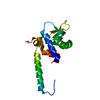

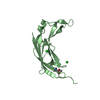
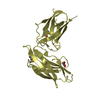

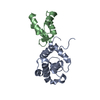
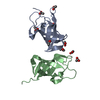
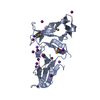
 PDBj
PDBj

















